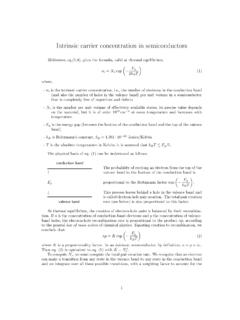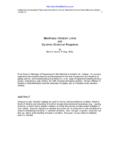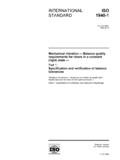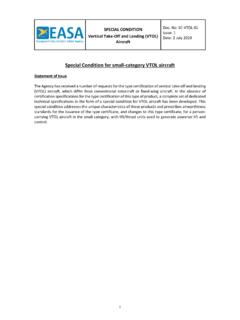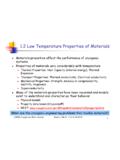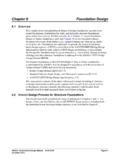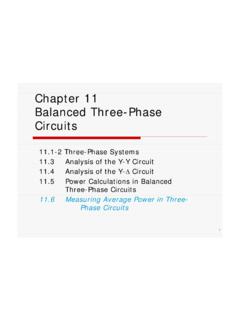Transcription of NEWTON’S PARTICLE THEORY OF LIGHT
1 1 NEWTON S PARTICLE THEORY OF LIGHTL ight is made up of little obey the same laws of physics as other masseslike baseballs and are tiny so the particles in two intersectingbeams do not scatter off each 1704 Newton published his treatise Opticks, this was 17 years after his great work Principia. He had waited until Robert Hook died, since he had become so sensitive to criticism, especially from Hook. Optickswas written in English, not the latin of Principia, and moreover, was much easier to read. It was very popular and he revised it three times. Newton proposed that LIGHT consists of little masses. This means that a horizontal beam of LIGHT near the earth is undergoing projectile motion, and forms a parabola. The straight line we observe is due to the fact that the speed of the particles is so great. In one microsecond, LIGHT travels 300 m. In that time it should fall a distance y = 1/2gt2= 5*10-12m, much too small to be known properties of LIGHT could be explained easily by a PARTICLE model.
2 For example it was known that when LIGHT reflects from a smooth surface, the angle of incidence is equal to the angle of reflection. This is also how an elastic, frictionless ball bounces from a smooth surface. As we shall see, a key property for the PARTICLE THEORY is THEORY OF REFRACTIONA LIGHT PARTICLE deep within a mediumexperiences no net an interface, between air andwater, LIGHT particles experience anattractive force towards the water. Could this be the cause of refraction?Newton imagined that matter is made of particles of some kind (today we would call them molecules or atoms). When a LIGHT PARTICLE is deep within a medium, such as water or glass, it is surrounded on all sides by equal numbers of these particles. Suppose there is an attractive force between the LIGHT particles and the matter particles. Then deep within a medium, these forces cancel each other out and there is no net force on the LIGHT , according to Newton s first law, the LIGHT PARTICLE will continue moving in a straight line since no net force acts on an interface the situation is different.
3 Now there are more matter particles on one side than the other, and the LIGHT PARTICLE can experience a net force. It would experience a briefattractive force towards the medium with more matter particles. 3airwatervairvwater i rvparvparAs the LIGHT PARTICLE moves into the water, it experiences a brief attractive force towards the water. This increases the vertical component of its velocity. Since it did not experience any net horizontal force, its horizontal velocity remains the brief vertical force speeds the LIGHT PARTICLE up, and deflects its velocity towards the surface normal, which is what is observed. As we have seen, the ratio of the sine of the angle of incidence to the sine of the angle of refraction is a constant for a given pair of materials. We can evaluate the sines of the two angles from the above diagram in terms of the velocity of the LIGHT PARTICLE in air and in S EXPLANATION OF SNELL S LAWsin( i) = vpar/vairsin( r) = vpar/vwatersin( i)/sin( r) = vwater/vairFrom the diagram on the previous slide we can immediately evaluate the sines of the angles of incidence and refraction.
4 In a right triangle the sine of an angle is equal to the ratio of the side opposite the angle to the hypotenuse. This is equal to the component of the LIGHT PARTICLE s velocity parallel to the surface divided by the magnitude of the velocity in each the LIGHT PARTICLE s velocity parallel to the surface does not change, since there is a force on the PARTICLE only perpendicular to the surface, this simplifies the ratio of the two sines. We see that the ratio of sines, which is just equal to the index of refraction, is equal to the ratio of the speed of the LIGHT PARTICLE in water to that in immediately explains why each pair of materials has a different value for the index of refraction. All Newton needed to do was to claim that the speed of LIGHT is different in different transparent materials. This is a simple explanation of Snell s law. Newton regarded it as one of his triumphs.
5 He concluded his discussion of this in his book Optickswith the words I take this to be a very convincing argument of the full truth of this proposition. 5 OTHER PROPERTIESC olorsPolarizationWhat about other properties of LIGHT such as the list of observations we compiled? Can Newton s PARTICLE model account for all of these?His explanation for the fact that a prism separates a beam of white LIGHT into the colors of the rainbow was simple. We have seen that red LIGHT refracts least, and violet LIGHT most. Newton stated that the mass of the LIGHT PARTICLE varied with color. Red LIGHT particles have more mass than violet, consequently they will be deflected less upon crossing an interface between materials. He assumed all LIGHT particles experience the same force on crossing an interface. What differs among them is their inertia. Red LIGHT particles with more inertia will be deflected less by the same force than violet LIGHT about polarization?
6 When we observe the intensity of LIGHT transmitted by two sheets of polaroid plastic we find it varies from a maximum to zero and back to a maximum again as the second polarizer is rotated. If the LIGHT particles were spherical, this could not happen. Newton stated that the LIGHT particles are not spherical, but have sides . Perhaps they are platelike, or rectangular. Visualizing a precise shape for the LIGHT particles is difficult. Clearly something other than a sphere is needed. 6 Decisive Test of PARTICLE Theorysourcerotating mirrorfixed mirrorairwaterwater-filled tubeWe have seen that Roemer used observations of the eclipses of Io to measure the speed of LIGHT in a vacuum. By 1850 the technology became available to do so in a laboratory. Foucault, in France, used a small steam turbine to spin a mirror at the rate of 800 rotations/sec(!). A LIGHT beam was reflected from it to another mirror 9m away.
7 When it returned, 60 ns later, the mirror had rotated a little, causing the return beam to be deflected a little below the source. When the mirror is at any other angle, the LIGHT beam is reflected elsewhere in the room and lost. Then what Foucault did was introduce a 3m long tube of water in the vertical LIGHT path. If Newton was right, and the LIGHT speed in water was greater than in air, then the return LIGHT beam would arrive in less than 60 ns, and its path would be deflected closer to the source. What Foucault found was that introducing the water-filled tube caused the LIGHT path to be deflected farther from the source. This showed that LIGHT travels more slowly in water than in air. This experiment was decisive. There was no way to save Newton s PARTICLE THEORY of LIGHT . This is a compelling example of how quickly a grand theoretical structure can collapse. All it takes is one decisive experiment like this one.
8 If there is no way to modify the THEORY to account for the new result, the THEORY must be abandoned. 7 WAVE MOTIONA wave is a pattern, or shape, or disturbance,traveling through a :Sound is a pressure wave in vibration of stretched stadium wave .As great as Newton was, his PARTICLE THEORY of LIGHT has failed. We must find a new model or THEORY . One other possibility is that LIGHT is a wave traveling through consists of waves traveling through air or another mechanical medium. What is waving when we hear sound? It consists of air pressure vibrations: What is waving is the air pressure. To create sound a vibrating object is needed. In an acoustic guitar the vibrating strings cause the guitar body to vibrate, transmitting the vibrations to the surrounding air. The guitar strings vibrate because of the tension in the strings. The vibration then travels along the string. SHOW long stretched spring.
9 Note how the wave shape reflects from the fixed end of the spring. 8 TORSIONAL WAVESW aves reflect from ends in this torsional wave apparatus looks like a crudely drawn fish skeleton. The backbone is a steel wire. When a crossbar at one end is rotated up and back down, the steel wire is twisted and transmits the rotational motion to the next crossbar. This process is repeated, and so the disturbance is transmitted along the steel backbone in a wavelike manner. SHOW Torsion wave see that the wave reflects from the ends of the structure, similarly to the example of the stretched spring. Reflection of waves from a sudden change in the medium seems to be a common feature. 9 FASTER TORSIONAL WAVESA torsion wave apparatus with shorter bars produces a faster wave propagation. The shorter bars have less inertia and so respond more quickly to the twist of the steel wire. Now if we join together an apparatus with long bars and one with short bars what will happen when we create a wave at one end?
10 SHOW connected torsion wave demo. We see that the wave is partially transmitted to the second skeleton, and partially reflected back towards the origin. This happens whichever side the wave comes from. This is a general feature of wave propagation. That when a wave encounters an interface between two media in which the wave speed differs, part of the wave energy is transmitted, and part is reflected. This reminds us of an air-glass or air-water interface for two wave amplitudes occur at the same point, they simply add. They do not scatter from each : Torsion waves passing througheach waves can occupy the same place at the same time. The total amplitude is simply the sum of the individual amplitudes. The two waves do not scatter from each other. In this way waves are completely different than material particles like billiard negative and positive wave crests passing through each other on the torsion wave demo.

